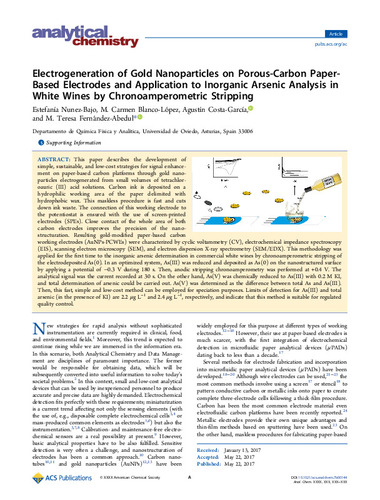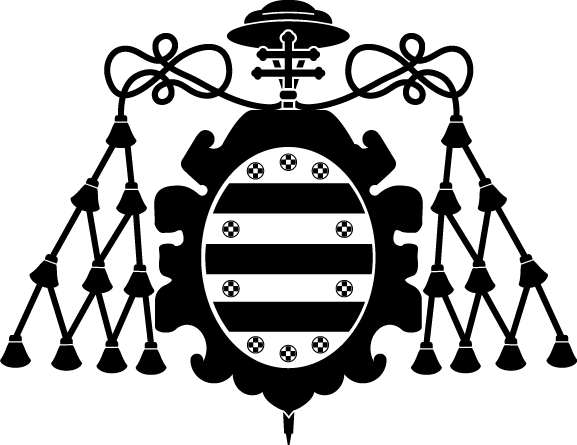Electrogeneration of Gold Nanoparticles on Porous-Carbon PaperBased Electrodes and Application to Inorganic Arsenic Analysis in White Wines by Chronoamperometric Stripping
Publication date:
Publisher version:
Citación:
Descripción física:
Abstract:
This paper describes the development of simple, sustainable, and low-cost strategies for signal enhancement on paper-based carbon platforms through gold nanoparticles electrogenerated from small volumes of tetrachloroauric (III) acid solutions. Carbon ink is deposited on a hydrophilic working area of the paper delimited with hydrophobic wax. This maskless procedure is fast and cuts down ink waste. The connection of this working electrode to the potentiostat is ensured with the use of screen-printed electrodes (SPEs). Close contact of the whole area of both carbon electrodes improves the precision of the nanostructuration. Resulting gold-modified paper-based carbon working electrodes (AuNPs-PCWEs) were characterized by cyclic voltammetry (CV), electrochemical impedance spectroscopy (EIS), scanning electron microscopy (SEM), and electron dispersion X-ray spectrometry (SEM/EDX). This methodology was applied for the first time to the inorganic arsenic determination in commercial white wines by chronoamperometric stripping of the electrodeposited As(0). In an optimized system, As(III) was reduced and deposited as As(0) on the nanostructured surface by applying a potential of −0.3 V during 180 s. Then, anodic stripping chronoamperometry was performed at +0.4 V. The analytical signal was the current recorded at 30 s. On the other hand, As(V) was chemically reduced to As(III) with 0.2 M KI, and total determination of arsenic could be carried out. As(V) was determined as the difference between total As and As(III).Then, this fast, simple and low-cost method can be employed for speciation purposes. Limits of detection for As(III) and total arsenic (in the presence of KI) are 2.2 μg L−1 and 2.4 μg L−1, respectively, and indicate that this method is suitable for regulated quality control.
This paper describes the development of simple, sustainable, and low-cost strategies for signal enhancement on paper-based carbon platforms through gold nanoparticles electrogenerated from small volumes of tetrachloroauric (III) acid solutions. Carbon ink is deposited on a hydrophilic working area of the paper delimited with hydrophobic wax. This maskless procedure is fast and cuts down ink waste. The connection of this working electrode to the potentiostat is ensured with the use of screen-printed electrodes (SPEs). Close contact of the whole area of both carbon electrodes improves the precision of the nanostructuration. Resulting gold-modified paper-based carbon working electrodes (AuNPs-PCWEs) were characterized by cyclic voltammetry (CV), electrochemical impedance spectroscopy (EIS), scanning electron microscopy (SEM), and electron dispersion X-ray spectrometry (SEM/EDX). This methodology was applied for the first time to the inorganic arsenic determination in commercial white wines by chronoamperometric stripping of the electrodeposited As(0). In an optimized system, As(III) was reduced and deposited as As(0) on the nanostructured surface by applying a potential of −0.3 V during 180 s. Then, anodic stripping chronoamperometry was performed at +0.4 V. The analytical signal was the current recorded at 30 s. On the other hand, As(V) was chemically reduced to As(III) with 0.2 M KI, and total determination of arsenic could be carried out. As(V) was determined as the difference between total As and As(III).Then, this fast, simple and low-cost method can be employed for speciation purposes. Limits of detection for As(III) and total arsenic (in the presence of KI) are 2.2 μg L−1 and 2.4 μg L−1, respectively, and indicate that this method is suitable for regulated quality control.
Patrocinado por:
This work has been supported by the Spanish Ministry of Economy and Competitiveness (MINECO) under Projects CTQ2011-25814 and CTQ2014-58826-R. E. Nunez-Bajo thanks MINECO for the award of a Ph.D. Grant BES-2012- 056713. Authors thank Prof. E. Blanco-Gonzalez, Prof. M. Montes-Bayon, and J. García-Fernández from the Departamento de Quimica Física y Analí tica, Universidad de Oviedo, for kindly determining the total arsenic concentration in white wines by ICP-MS.
Collections
- Artículos [37532]
- Investigaciones y Documentos OpenAIRE [8366]
- Química Física y Analítica [635]
Files in this item




